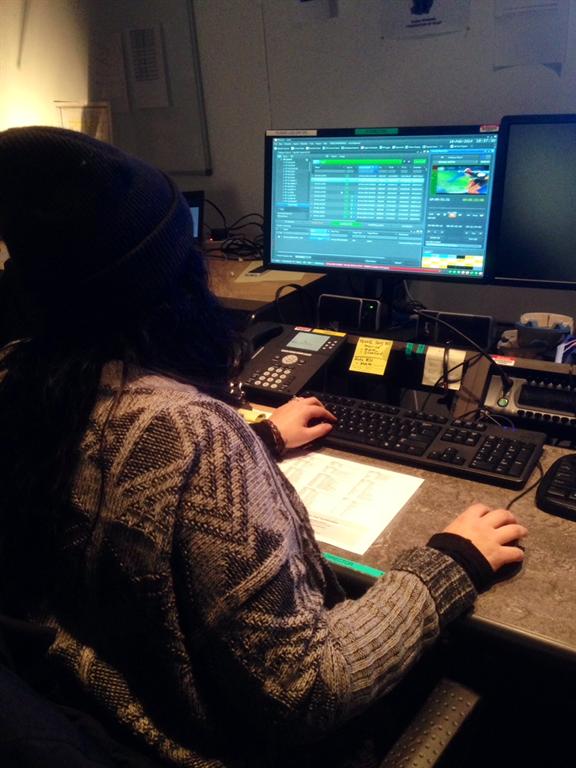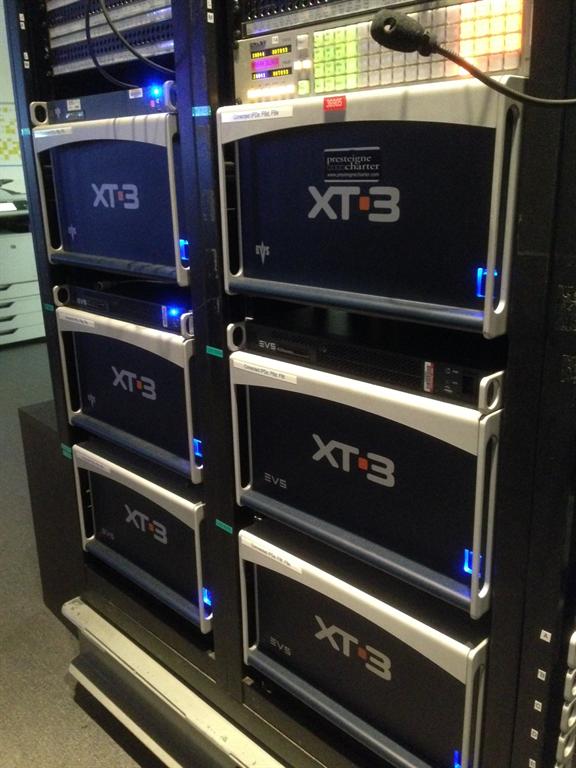Servers at NBC Olympics: Reaching a Goal

An IPDirector station inside NBC Olympics’ Central Ingest area.
SOCHI — The Sochi Games saw NBC Olympics reach a major milestone in its 10+ year march toward true file-based production, shared across sites. For the first time, users at key venues, the International Broadcast Center or based in the U.S. can all “remote” the broadcaster’s archive resident within the new NBC Sports facility located in Stamford, Conn.
A COLLABORATIVE SYSTEM & EFFORT
Best-of-breed servers from EVS, Avid and Harmonic helped the multi-year Games rightsholder fulfil its long-sought production goal of true, global remote access to the archive.
A total of 45 Avid Media Composer Edit Seats, aided by ISIS storage, and Interplay manage most editing duties. File-based movement is handled by NBC’s Avid Media Asset Management system (the MAM), ingesting video from 40 channels of Harmonic Media Decks, plus 300TB Media Grid storage pools located in Sochi and Stamford. All truck replays and live playback video are recorded using more than 60 EVS XT2 and (mostly) XT3 HD video servers.
Beyond the three main hardware vendors whose boxes can be seen all over the racks of the IBC, several specialty vendors had important roles. Long-time NBC partner Cyradis handled device control, and fellow Canadian company File Catalyst made its NBC Olympics debut, providing file acceleration. SpectraLogic managed robotics for the LTO-5 tape library. SGL provided the middleware that talks to the robot, and Telestream’s Vantage product does transcoding and some file-based standards conversion.
EVS’ role played to its strengths. Networked XTs are the basis for the playback area, where the machines’ clip transfer capability has become the standard for quick-turnaround production. All of the XTs are connected via a Gigabit Ethernet network that also includes Avid editing systems. Avid’s DNX codec allows direct file transfer between Avid editing and EVS playback servers.

Networked EVS XT3s are the basis for the NBC Olympics playback area. EVS’ IPDirector software was also key. This is essentially a database management system that can look at the content of all XTs on the EVS network for clip viewing and retrieval. Large segments of the Primetime Show, the lengthy Sports Network Daypart and more saw XT3s used as traditional playback devices, controlled with both EVS LSMs and IPDirector seats to build playlists.
Venue connectivity took a big step forward in Sochi. “For the first time, (creatives) are not only pushing IPDirector database EDLs and clips to the MAM, they’re also pushing to key venues,” said Darryl Jefferson, VP of Digital Workflow for NBC Olympics.
One important seat of IPDirector is provided by host broadcaster OBS. The IPBrowse software within IPDirector allows access to the very large OBS EVS server pool, where every minute of Games content is archived.
Another management software saw a significant increase in use from London 2012: EVS’ XSquare management tool for file transfers. XSquare managed about 10 watch folders in London, but in the Sochi production this number had increased to nearly 70.
These watch folders manage content coming in from venues or the MAM, and deliver and receive from the Avids and so forth, often in multi-destination deliveries in “set and forget” processes. Less than one week in to the Games, more than 15,000 files had been sent.
FROM CENTRAL TAPE TO CENTRAL INGEST
NBC’s commitment to and confidence in its MAM system has reached the level where the traditional “record wall” of tape or optical disc machines in a sector of the IBC that has been called “Central Videotape” for decades, is officially no more. Although the recording format has not changed since Vancouver, the record devices are now eight four-channel Harmonic MediaDecks.
To a large extent, most of the Sochi production workflow mirrors what worked well in London, but with a greater commitment to the MAM. “For the past year we’re operating this way in Stamford, and we realized it was possible to run this way for the Olympics as well,” said Matt Green, Senior Digital Media Engineer.
“In London we left ourselves a safety net by building off Sony’s XDCAM (optical disc) stations. … If we lost automation, if we lost asset management, if we lost central storage, we could put everything on optical discs as we had done in Vancouver and Beijing.”
Not having handheld media in a production process can be a hurdle for some users, but adoption rates have exceeded expectations, and the benefits have become obvious to end users.
“The thing that’s remarkable to us as stewards and watchers of the project is that as soon as people can access the entire library, there’s really no way to put that genie back in the bottle,” said Jefferson.
The professional video industry's #1 source for news, trends and product and tech information. Sign up below.

